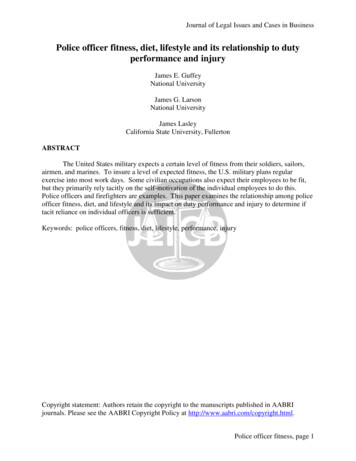
Transcription
Journal of Legal Issues and Cases in BusinessPolice officer fitness, diet, lifestyle and its relationship to dutyperformance and injuryJames E. GuffeyNational UniversityJames G. LarsonNational UniversityJames LasleyCalifornia State University, FullertonABSTRACTThe United States military expects a certain level of fitness from their soldiers, sailors,airmen, and marines. To insure a level of expected fitness, the U.S. military plans regularexercise into most work days. Some civilian occupations also expect their employees to be fit,but they primarily rely tacitly on the self-motivation of the individual employees to do this.Police officers and firefighters are examples. This paper examines the relationship among policeofficer fitness, diet, and lifestyle and its impact on duty performance and injury to determine iftacit reliance on individual officers is sufficient.Keywords: police officers, fitness, diet, lifestyle, performance, injuryCopyright statement: Authors retain the copyright to the manuscripts published in AABRIjournals. Please see the AABRI Copyright Policy at http://www.aabri.com/copyright.html.Police officer fitness, page 1
Journal of Legal Issues and Cases in BusinessINTRODUCTIONRationale for the StudyIt would seem self-evident that an occupation such as policing would demand that policeofficers stay fit as a part of the job requirements. Police officers are engaged in physicalchallenges on a regular basis. For example, they chase fleeing suspects; they climb over fencesand onto roof tops; they subdue resisting arrestees; and they lift heavy objects such as recoveredstolen property. These often daily job requirements require strength and endurance that isobtained by a combination of aerobic and anaerobic exercise. Adding to this physical challengeis the fact that officers must carry bulky items of additional weight on a pistol belt: handgun,baton, mace, handcuffs, and Taser. Therefore, it would seem appropriate that police and sheriffdepartments would emphasize fitness by providing gym memberships to officers as an incentive,or that police officers would be self-motivated and place emphasis on fitness and reserve offduty time to maintain fitness. Fitness/wellness of police officers has been the focus on manystudies; nevertheless, the authors felt it needed attention once again. Fitness is an important andvital factor for the success of policing, and this paper looks at a sample of police officers to seethe results.LITERATURE REVIEWIntroductionThe literature on police officer fitness is significant so the authors have identified specificareas to cover so that the reader has understanding of the issues involved in police officer fitnessand wellness. These topic areas are (a) selected examples of both international and United Statesefforts toward fitness, (b) police union resistance, (c) termination of police officers, and (d)comparative studies.Selected Examples of Police Fitness Efforts InternationallyPolicing is an important function of local and national governments throughout the world.All nations strive to provide their citizens with the most effective policing within the constraintsof budgets and legal mandates. Police officer fitness has been an issue for police departments asfar back as the Sir Robert Peel’s Bobbies and the London Metropolitan Police Department whichwas established in 1829 by a Parliamentary act (Summerscale, 2008). (CITE)Police officer fitness is not restricted to United States police departments. “SeniorSuperintendent Lindela Mashigo of the Pretoria, South Africa Police Department recently startedrunning, inspired by his police commissioner, Bheki Cele, who he describes as a “fitnessfanatic.” Cele launched the SA Police Service (SAPS) fitness and wellness programme, whichhopes to encourage the country’s tubby police officers to fight the flab by keeping physically fitthrough exercise and by following a healthy diet” (Bega, 2010, p. 4).Superintendent Brett Pointing of the Queensland, Australia Police Department boasts ofhis completion of the FBI National Academy’s Yellow Brick Road—a notoriously difficult USMarine Corp obstacle course that is considered one of the toughest in existence. “The higherlevel of fitness helps the police executive cope with their workload, and we learned aboutPolice officer fitness, page 2
Journal of Legal Issues and Cases in Businessnutrition, diet and the metabolism,”(Wilson, 2005, p.48) said a leaner police officer who has nowbecome a 10 km runner and will compete in this year’s Gold Coast Marathon.The London Metropolitan Police, the oldest police department in the world, has becomeexceptionally tough on unhealthy police officers. Fat or unhealthy police officers could beforced to resign. One idea is to have officers take a fitness test every 3 years. If they fail, theywould be placed on unpaid administrative leave until they increase fitness levels and pass thefitness test and change their lifestyle. If there were still no sign of improvement, they could beforced to resign. “Figures released by the London Metropolitan Police Department in early 2003show that the London Metropolitan Police take nearly twice the number of sick days as theaverage City of London private sector worker. This results in nearly 1.5 million police workingdays being lost annually” (Taylor, 2003, p. 34).In Ontario Province, Canada, all police officers must meet annual fitness standards.Owen Sound City police constable, Brian Dunham, stated, “You don’t have to be a runner to be apolice officer, but if you’re not in fairly good shape you run a real risk of hurting yourself andmaybe having a heart attack” (Algie, 2001, p. A3).The National Police of one Asian country set up a six-month fitness campaign for its113,000 members. “The most notable feature of the campaign was to reduce the waistline ofpolice officers to a maximum of 36 inches. Twice per week the officers were required to doaerobic exercises, timed jogs, push-ups and pull-ups. There were regular command-sponsoredmass exercises and ballroom dancing” (Siruno, 2009, p. 54).Selected Examples of Police Fitness Efforts in the United StatesDr. Kota Reddy, a cardiologist in Houston, Texas, offers free cardiac screenings to policeofficers in the Sugar Land and Missouri City public safety departments. An interventionalcardiologist, Reddy has long been aware that heart disease is rampant in public safetyoccupations. “Stress, poor diets and work environments that mix sedentary hours with suddenintense physical activity make police officers significantly more vulnerable. He cites studies thatshow heart disease causes 45 percent of on-duty firefighter deaths and 22 percent of policeofficer deaths” (Hastings, 2008, p. 9).Quire and Blount’s 1990 study of 380 sworn police officers of the St. Petersburg, FloridaPolice Department found that older officers were at greater risk of coronary heart disease thanyounger officers. Nevertheless, based on Center for Disease Control standards, St. Petersburgpolice officers were at very low risk levels and had significantly reduced their risk level over aperiod of 5 years from 1981-1985. This reduction was attributed to a concentrated effort on thepart of the department, and in particular complete physical examinations, that contained thecholesterol screen and the resultant discussion of risk profiles, and a fitness program thatcontained exercise and diet recommendations.Diet and exercise must go together. The combination maximizes the level of fitness andstored energy in one’s body. Mark Farmer is a Lieutenant with the Aiken, South Carolina PublicSafety Department. He is also a certified physical fitness coordinator through the Federal LawEnforcement Training Center (FLETC). Farmer discusses the need for police officers to stay inshape by engaging in regular exercises and maintaining a balanced nutrition and diet by havingthe right amounts of proteins, carbohydrates, and fats. “Physical exercise and diet must be donetogether. Think of it as a positive and negative on a battery. If one end is not connected, youhave no power.” (Farmer, 2004, p. 34). He states there are a total of 25 amino acids which, whenPolice officer fitness, page 3
Journal of Legal Issues and Cases in Businessput together in different combinations, make different kinds of protein that you need to formyour cells and organs. Eight of these amino acids are called essential—and from these your bodycan make the remaining 17. These proteins can be found in chicken, tuna, black beans, fish, andred meat. He admonishes against frying! Frying not only takes away a large amount of the goodstuff, but it also adds saturated fat” (Farmer, p. 35).Saturated fat is to be avoided as much as possible in one’s diet. According to the Centersfor Disease Control, “diets high in saturated fat have been linked to chronic disease, specifically,coronary heart disease. The Dietary Guidelines for Americans 2010 recommend consuming lessthan 10% of daily calories as saturated fat. In general, saturated fat can be found in the followingfoods: high-fat cheeses, high-fat cuts of meat, whole-fat milk and cream, butter, ice cream andice cream products, and palm and coconut oils.” (Centers for Disease Control, p. 1)Litigation, Termination of Police Officers, and Police Union ResistanceThe legality of terminating police officers based on departmental fitness standards hingeson the court’s interpretation of Title VII of the Civil Rights Act of 1964. Title VII prohibitsemployment discrimination based on race, color, religion, sex and national origin. With regardto fitness standards, one issue of concern has been holding female officers to the same standardas male officers. In the case of Lanning v. Southeastern Pennsylvania Transportation Authority1998 WL 341605 (E.D.Pa., 1998), the U.S. District Court for the Eastern District ofPennsylvania handed down a decision in 1998.In 1991, as a part of an effort to upgrade its 234 officer police force, the SoutheasternPennsylvania Transportation Authority (SEPTA) which operates a commuter rail system inPhiladelphia and its suburbs, instituted a series of physical fitness requirements for both on-boardand potential police officers. Among these was a requirement that applicants complete a 1.5 milerun in 12 minutes. Failure to meet this standard disqualified an applicant from employment as apolice officer (Brooks, 2012, p.28).In 1997, five women brought suit against SEPTA because they had failed to meet the abovestandard. The U.S. District Court for the Eastern District of Pennsylvania found in favor ofSEPTA because SEPTA was able to show that a certain aerobic capacity was necessary for thejob of SEPTA police officer. SEPTA provided data wherein police officers had been unable tocapture suspects in short pursuits, and this had led to escapes by felons thus endangering thepublic.In 2007, a Bellevue, Washington police officer was fired for violating a part of adepartment policy that requires officers to maintain a high level of physical conditioning throughregular exercise and proper diet. Chris Parent, 51, fought for his job in a civil servicecommission hearing. Parent was fired on November 28, 2007 for violating a policy that reads;“Police officers are called upon to perform a variety of tasks that require physical endurance andagility. This dictates that officers maintain a high level of physical, mental and emotionalcondition, which can only be acquired through regular exercise, proper diet and utilizing time”(Palmer and Kuiper, 2008, p.2).More recently, three Suquamish, Washington police officers were fired in April, 2011following the department’s high-stakes fitness program. The department’s officers are expectedto pass a yearly fitness test of push-ups, sit-ups, a 300-meter dash, and a 1.5 mile run—the latertwo are timed events (Farley, 2011).Police unions have generally resisted attempts by police and city administrators toimplement physical fitness written policies and physical fitness tests for sworn police officers.Police officer fitness, page 4
Journal of Legal Issues and Cases in BusinessThe unions’ efforts have generally been successful in larger departments with strong policeunions. The future of union resistance is uncertain as it will most likely depend of the direct oflitigation—particularly by the United States Supreme Court which has so far refused to hearcases on this issue.Comparative StudiesThe following are five studies which are similar to the authors’ study.Study #1. The most comprehensive 20th Century study of police officer fitness wasconducted by the Cooper Institute for Aerobics Research (CIAR) between 1983 and 1993 thatrandomly sampled approximately 1,700 officers from different law enforcement agencies acrossthe country (Quigley, 2008). This study found that officers’ average fitness levels were belownormal in the areas of aerobic fitness, body fat, and abdominal strength. Fitness levels wereaverage in upper body strength and low back flexibility. Overall fitness of law enforcementofficers in most areas of the US was less than that of 50 percent of Americans during this timeperiod (Quigley).As a result of the Cooper Institute for Aerobics Research work, police officers can applyto attend the Law Enforcement Fitness Specialist Course. This is a 4.5 day course designedspecifically for the law enforcement and public safety professional who is involved indeveloping and delivering physical fitness programs (The Cooper Institute, 2001).Study #2. G. Gregory Tooker and David Cashwell (2007) of the Commission onAccreditation of Law Enforcement Agencies (CALEA) completed a pilot study begun by Tookerand Smith (2005) on behalf of the National League of Cities local government self-insuranceorganizations. The authors and CALEA sought participation in their study from several states;however, only the State of North Carolina participated. The pilot study was conducted in sevenNorth Carolina agencies and subseq
foods: high-fat cheeses, high-fat cuts of meat, whole-fat milk and cream, butter, ice cream and ice cream products, and palm and coconut oils.” (Centers for Disease Control, p. 1) Litigation, Termination of Police Officers, and Police Union Resistance The legality of terminating police officers based on departmental fitness standards hinges











